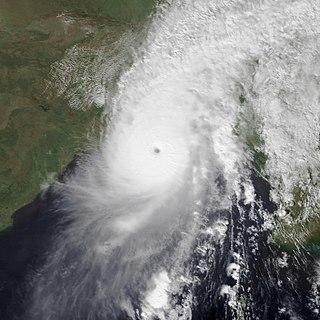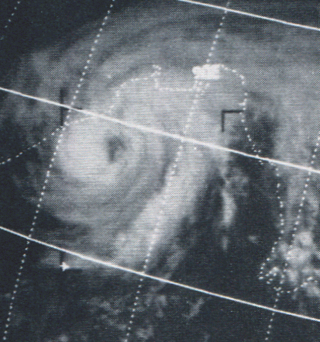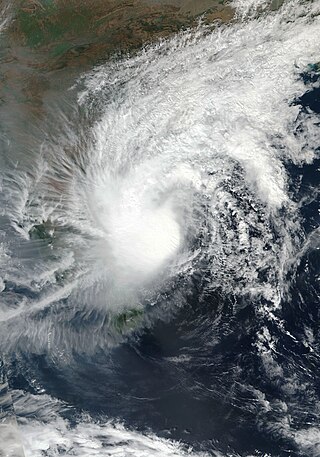
The 1999 Odisha cyclone was the most intense recorded tropical cyclone in the North Indian Ocean and among the most destructive in the region. The 1999 Odisha cyclone organized into a tropical depression in the Andaman Sea on 25 October, though its origins could be traced back to an area of convection in the Sulu Sea four days prior. The disturbance gradually strengthened as it took a west-northwesterly path, reaching cyclonic storm strength the next day. Aided by highly favorable conditions, the storm rapidly intensified, attaining super cyclonic storm intensity on 28 October, before peaking on the next day with winds of 260 km/h (160 mph) and a record-low pressure of 912 mbar. The storm maintained this intensity as it made landfall on Odisha on 29 October. The cyclone steadily weakened due to persistent land interaction and dry air, remaining quasi-stationary for two days before slowly drifting offshore as a much weaker system; the storm dissipated on 4 November over the Bay of Bengal.

Natural calamities in India, many of them related to the climate of India, causes of the massive losses of life and property. Droughts, flash floods, cyclones, avalanches, landslides brought by torrential rains, and snowstorms pose the greatest threats. A natural disaster might be caused by earthquakes, flooding, volcanic eruption, landslides, hurricanes etc. In order to be classified as a disaster, it will need to have a profound environmental effect and/or human loss and frequently incurs a financial loss. Other dangers include frequent summer dust storms, which usually track from north to south; they cause extensive property damage in North India and deposit large amounts of dust and dirt from arid regions. Hail is also common in parts of India, causing severe damage to standing crops such as rice and wheat and many more crops and effects many people.

Extremely Severe Cyclonic Storm Sidr was a tropical cyclone that resulted in one of the worst natural disasters in Bangladesh. The fourth named and the deadliest storm of the 2007 North Indian Ocean cyclone season, Sidr formed in the central Bay of Bengal, and quickly strengthened to reach peak 1-minute sustained winds of 260 km/h (160 mph), making it a Category-5 equivalent tropical cyclone on the Saffir–Simpson scale. The storm eventually made landfall in Bangladesh on November 15, 2007, causing large-scale evacuations. At least 3,447 deaths have been blamed on the storm, with some estimates reaching 15,000.

The National Disaster Response Force (NDRF) is an Indian specialised force constituted under the Disaster Management Act, 2005.

Extremely Severe Cyclonic Storm Phailin was one of the most intense tropical cyclones to make landfall in India since the 1999 Odisha cyclone. The system was first noted as a tropical depression on October 4, 2013, within the Gulf of Thailand, to the west of Phnom Penh in Cambodia. Over the next few days, it moved westwards within an area of low to moderate vertical wind shear, before as it passed over the Malay Peninsula, it moved out of the Western Pacific Basin on October 6. It emerged into the Andaman Sea during the next day and moved west-northwest into an improving environment for further development before the system was named Phailin on October 9, after it had developed into a cyclonic storm and passed over the Andaman and Nicobar Islands into the Bay of Bengal.

The 1971 Odisha cyclone was a devastating tropical cyclone that struck the Indian state of Odisha on October 29, 1971. The cyclone also affected the Indian state of West Bengal as well as East Pakistan, which had been devastated by the 1970 Bhola cyclone just less than a year prior and was in the middle of Bangladesh Liberation War.

National Disaster Management Authority (India), abbreviated as NDMA, is an apex Body of Government of India, with a mandate to lay down policies for disaster management. NDMA was established through the Disaster Management Act enacted by the Government of India on 23 December 2005. NDMA is responsible for framing policies, laying down guidelines and best-practices for coordinating with the State Disaster Management Authorities (SDMA's) to ensure a holistic and distributed approach to disaster management.

Extremely Severe Cyclonic Storm Hudhud was a strong tropical cyclone that caused extensive damage and loss of life in eastern India and Nepal during October 2014. Hudhud originated from a low-pressure system that formed under the influence of an upper-air cyclonic circulation in the Andaman Sea on October 6. Hudhud intensified into a cyclonic storm on October 8 and as a Severe Cyclonic Storm on October 9. Hudhud underwent rapid deepening in the following days and was classified as a Very Severe Cyclonic Storm by the IMD. Shortly before landfall near Visakhapatnam, Andhra Pradesh, on October 12, Hudhud reached its peak strength with three-minute wind speeds of 185 km/h (115 mph) and a minimum central pressure of 960 mbar (28.35 inHg). The system then drifted northwards towards Uttar Pradesh and Nepal, causing widespread rains in both areas and heavy snowfall in the latter.

The All India Disaster Mitigation Institute (AIDMI) is a NGO registered in India. Located at Ahmedabad, Gujarat, India, it works on disaster risk reduction, climate change adaptation and disaster mitigation. It is a community-based; action planning, action research and advocacy organization, working towards bridging the gap between policy, practice and research related to disaster mitigation. AIDMI have been working on six pillars: (i) Awareness generation, (ii) Capacity building, (iii) Policy advocacy, (iv) Direct implementation, (v) Research and publications, and (vi) Networking.

Cyclonic Storm Roanu was a relatively weak tropical cyclone that caused severe flooding in Sri Lanka and Bangladesh during May 2016. It is the first tropical cyclone of the annual cyclone season. Roanu originated from a low-pressure area that formed south of Sri Lanka, which gradually drifted north and intensified into a cyclonic storm on 19 May. However, wind shear and land interaction caused it to weaken slightly, before reintensifying as it accelerated towards the coast of Bangladesh.
Disaster management in India — policies, laws, routines, and courses-of-action to aid in the conservation and recovery of lives and property during a natural or man-made disaster. Disaster management plans are multi-layered, and are planned to address issues such as floods, hurricanes/cyclones, fire, mass failure of utilities (blackouts) and the rapid spread of disease (pandemic).
From a meteorological standpoint, India is especially vulnerable to natural disasters due to its unique location below the Himalayas as well as its geo-climatic conditions and varied landscapes; monsoons, subsequent landslides and floods, droughts, famine, wildfires, cyclones, and earthquakes are all experienced to varying degrees on the Subcontinent, in addition to areas of dense overpopulation being at greater risk for disease outbreak and sanitation concerns, in the event of a natural disaster.
Due to this vastness of the country, different regions are vulnerable to different natural disasters. For example, during monsoon season, it is the peninsular regions of South India that are generally most affected, as well as by cyclone or tsunami; the more temperate to arid states of western India risk severe drought, famine and/or wildfire during summer. The more remote, mountainous regions of the North, especially the Himalayan states, can experience devastating avalanches in winter, spring flooding and major landslides during wet periods. This is in addition to earthquakes which, in the mountains, bring the potential for increased devastation due to falling rocks, mudslides, and flash floods.

The 2019 North Indian Ocean cyclone season was the second most active North Indian Ocean cyclone season on record in terms of cyclonic storms, the 1992 season was more active according to the Joint Typhoon Warning Center. The season featured 12 depressions, 11 deep depressions, 8 cyclonic storms, 6 severe cyclonic storms, 6 very severe cyclonic storms, 3 extremely severe cyclonic storms, and 1 super cyclonic storm, Kyarr, the first since Cyclone Gonu in 2007. Additionally, it also became the third-costliest season recorded in the North Indian Ocean, only behind the 2020 and 2008 seasons.

Extremely Severe Cyclonic Storm Fani was the worst tropical cyclone to strike the Indian state of Odisha since the 1999 Odisha cyclone. The second named storm and the first severe cyclonic storm of the 2019 North Indian Ocean cyclone season, Fani originated from a tropical depression that formed west of Sumatra in the Indian Ocean on 26 April. Vertical wind shear at first hindered the storm's development, but conditions became more favorable for Fani on 30 April. Fani rapidly intensified as a result, peaking at an Extremely Severe Cyclonic Storm with winds of 215 km/h. The Joint Typhoon Warning Center (JTWC) assessment its peak as a Category 5-equivalent intensity with winds of 280 km/h, making it the strongest north Indian Ocean tropical cyclone on record in terms of 1-minute sustained winds. Fani slightly weakened before making landfall in Odisha a few days later. Its convective structure rapidly degraded thereafter, degenerating into a remnant low on 4 May, and dissipating on the next day. It was the second-costliest Northern Indian tropical cyclone on record until it was surpassed by Cyclone Amphan in 2020.
The Odisha Disaster Rapid Action Force (ODRAF) is a specialised unit of Odisha Police constituted "To act immediately in case of disaster which may be due to natural calamity or industrial accident" by a state home department resolution.

Super Cyclonic Storm Amphan was an extremely powerful and catastrophic tropical cyclone that caused widespread damage in Eastern India, specifically in West Bengal and Odisha, and in Bangladesh, in May 2020. It was the strongest tropical cyclone to strike the Ganges Delta. It was a rare cyclone that lashed northern Bangladesh from Rajshahi to Rangpur in the early hours of 21 May with strong winds. It caused severe damage to mango production of Rajshahi and Rangpur. It was also the fourth super cyclone that hit West Bengal and Kolkata since 2015 as well as being one of the strongest storms to impact the area. Causing over US$15 billion of damage, Amphan is also the costliest cyclone ever recorded in the North Indian Ocean, surpassing the record held by Nargis of 2008.

During the heavy rainfall over the monsoon period from 1 June to 18 August 2020, all 14 districts in Kerala were affected with 104 dead and 40 injured. Four districts in Kerala were flooded on 7 August 2020. Major reported incidents in relation to flooding include a landslide in Idukki district on 6 August, claiming 66 lives and an Air India plane crash that caused the death of 21 people. The 2020 flood in Kerala marked the third year in a row of severe monsoon flooding.

Very Severe Cyclonic Storm Titli was a deadly and destructive tropical cyclone that caused extensive damage to Eastern India in October 2018. Titli was the twelfth depression and fifth named storm to form in the 2018 North Indian Ocean cyclone season. Titli originated from a low pressure area in the Andaman Sea on October 7. With warm sea surface temperatures and low wind shear, the low developed into a depression on October 8 in the central Bay of Bengal. It was tracked and followed by the India Meteorological Department (IMD), which also issued warnings and notices for the public. Titli continued to intensify at it moved toward the southeast Indian coast, becoming a very severe cyclonic storm, equivalent to a minimal hurricane on the Saffir–Simpson scale. It attained the intensity at the same time Cyclone Luban in the Arabian Sea was at the same intensity, marking the first instance since 1977 of simultaneous storms. The IMD estimated peak winds of 150 km/h (95 mph), while the American-based Joint Typhoon Warning Center (JTWC) estimated peak winds of 195 km/h (120 mph). Late on October 10, Titli made landfall in Andhra Pradesh, and it quickly weakened over land as it turned to the northeast. It degenerated into a remnant low on October 12.

Cyclone Amphan was the costliest tropical cyclone ever recorded in India and the North Indian Ocean, and the strongest cyclone ever since the 1999 Odisha Cyclone. It was the first storm, and strongest of the historic 2020 North Indian Ocean cyclone season, the costliest recorded cyclone season. It made landfall in West Bengal with 100 mph winds. Within India, the storm killed 103 people, and caused $14 billion in damage. Amphan produced extremely high winds that ripped roofs off houses and uprooted trees, and storm surges of 15 ft (4.6 m) in areas like Digha, West Bengal.

Severe Cyclonic Storm Phethai was a tropical cyclone which affected some portions of Sri Lanka and India during December 2018. The fourteenth depression, ninth deep depression, seventh cyclonic storm, and fifth severe cyclonic storm of the 2018 North Indian Ocean cyclone season, Phethai developed from an area of low pressure that formed over the Bay of Bengal on December 13. Having forecasted not to develop significantly, the depression then strengthened to a deep depression later that day before becoming a cyclonic storm on December 15. Phethai further intensified and peaked to a severe cyclonic storm, the following day. The system then steadily weakened due to land interaction and increasing wind shear, before making landfall as a disorganized system over Andhra Pradesh on December 17. It degenerated to an area of low-pressure inland later that day.

Very Severe Cyclonic Storm Yaas was a relatively strong and very damaging tropical cyclone that made landfall in Odisha and brought significant impacts to West Bengal during late May 2021. The second cyclonic storm, second severe cyclonic storm, and second very severe cyclonic storm of the 2021 North Indian Ocean cyclone season, Yaas formed from a tropical disturbance that the Indian Meteorological Department first monitored on May 23. Conditions in the basin favored development as the system became a deep depression later that day, before intensifying into a cyclonic storm on the next day, receiving the name Yaas. The system further intensified as it turned to the northeast, becoming a severe cyclonic storm on May 24 despite moderate wind shear. Marginally favorable conditions further continued as Yaas accelerated northeastward, strengthening to a Category 1-equivalent tropical cyclone and to a very severe cyclonic storm on May 25. Yaas crossed the northern Odisha coast around 20 km south of Balasore at its peak intensity as a very severe cyclonic storm on May 26. Upon landfall, the JTWC and IMD issued their final advisories as Yaas further weakened inland while turning north-northwestwards.


















